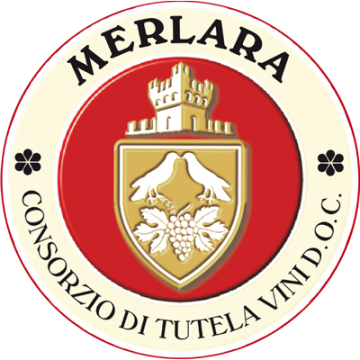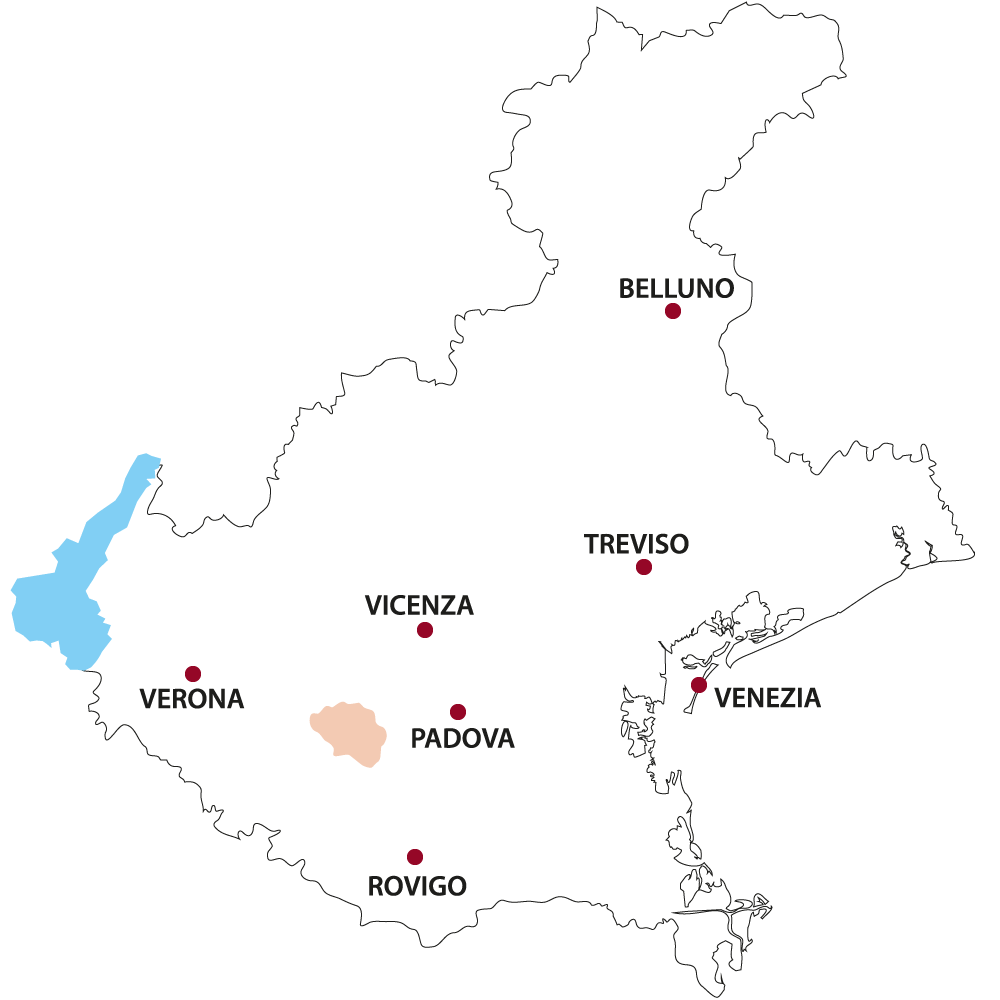

Zona di produzione
In the southern plains of the Veneto region, where the provinces of Padua and Venice meet, the territory still retains a strong agricultural vocation with the presence of fruit and vegetable cultivations and a wine-growing history spanning over five centuries. In fact, the presence of vineyards dates back to the 16th century when the grapes were harvested and processed into wine in the cellars of the courts that once dotted the countryside. Documents refer to the wine of the territory, served in inns or sold directly to wayfarers that travelled the ancient roads between the main towns of the Veneto Region. Crossed by the Adige and Fratta rivers and a dense network of drainage canals that keep the soil dry and ensure water in case of a drought, the plain between the lowland areas of the provinces of Padua and Verona has always been dedicated to the cultivation of vines like Cabernet and Merlot as well as Malvasia and Tocai Friulano. The D.O.C. “Merlara” was approved in 2000 followed by the Consortium of Protection the year after. The production area includes the entire administrative territory of the municipalities of Masi, Castelbaldo, Merlara, Urbana, Casale di Scodosia as well as part of the Montagnana territory in the province of Padua and Terazzo, Bevilacqua, Boschi Sant’Anna in the province of Verona. The Consortium of Protection has since 2008 become part of the Collis Consortium (Veneto Wine Group) that gathers producers from the provinces of Verona, Vicenza and Padua.
Caratteristiche e tipologie vino
The Merlara D.O.C. includes all the main varieties of white and red wines produced in the Veneto plains as well as some semi-sparkling, aromatic and lively wines (Bianco, Chardonnay, Marzemino) and Novello, the first wine to be placed on the market. The Merlara Bianco is obtained from Tocai Friulano grapes in a proportion varying fom 50% to 70%. White-berried nonaromatic grapes recommended and/or authorized for the provinces of Padua and Verona may contribute to a maximum of 50%. The Rosso is obtained from 50% to 70% Merlot grapes and a maximum of 50% of grapes from Cabernet Franc, Sauvignon, Carmenère and Marzemino (singly or jointly). Red-berried nonaromatic grapes recommended and/or authorized by the provinces of Padua and Verona may contribute for no more than 15%. Tocai, Malvasia, Merlot, Cabernet Sauvignon and Marzemino wines must be obtained from grapes of the eponymous vine for at least 85% and the remaining may be made up by non-aromatic grapes of the same colour, recommended and /or authorized for the provinces of Padua and Verona. Finally, the production of Cabernet can comprise, jointly or separately, Cabernet Franc and Cabernet Sauvignon grapes for a minimum 85% and a maximum 15% of non-aromatic grapes of the same colour recommended and/ or authorized for the provinces of Padua and Verona. The Merlara D.O.C. wines fully reflect the oenological tradition of a territory whose producers have managed to introduce innovative elements to the modified production rules in 2009.
Grapes
-
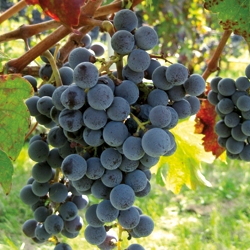
MERLOT
-
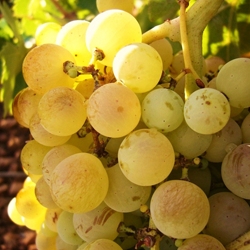
CHARDONNAY
-
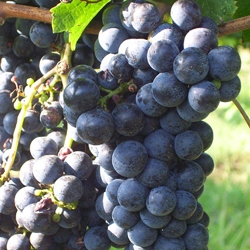
CABERNET FRANC
-
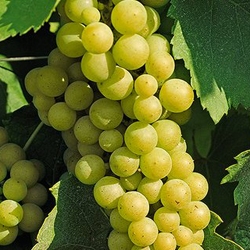
TOCAI FRIULANO
-
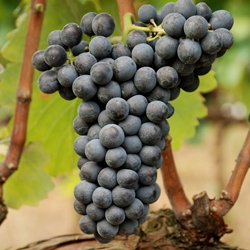
CABERNET SAUVIGNON
Merlot, Cabernet Franc, Cabernet Sauvignon, and Chardonnay grapes are the most widespread and cultivated in the area of the D.O.C. ‘Merlara” for the production of red and white wines. Also important is the contribution of Tocai Friulano, the historic vine of Veneto, from which the famous and much appreciated wine today called Tai is produced. From the Malvasia Istriana results an excellent white wine, developed recently by some local enterprises also in the Brut version using the Charmat method. Another innovation is the Marzemino Frizzante, a sweet and fruity red, which is particularly ideal with rustic sweets and dried fruit.
White Wines
MERLARA BIANCO
Colour: straw-like yellow tending to greenish;
Bouquet: vinoso, caratteristico, intenso e delicato;
Taste: secco, di medio corpo, armonico, leggermente amarognolo;
Alcoholic Strength minimum total volume: 11,00%
Accompaniments: minestre, pesce, formaggi teneri.
MERLARA BIANCO FRIZZANTE
Colour: giallo paglierino, a volte verdognolo, brillante;
Bouquet: vinoso, caratteristico, intenso e delicato;
Taste: secco di medio corpo, aromatico, leggermente amarognolo, frizzante;
Alcoholic Strength minimum total volume: 10,50%
Accompaniments: aperitif, starters.
Foam: evanescente;
MERLARA TAI
Colour: straw-like yellow, with greenish reflections
Bouquet: intenso, tipico;
Taste: secco, morbido, pieno;
Alcoholic Strength minimum total volume: 11,00%
Accompaniments: antipasti di verdure, risotti, pesce, fritti rustici.
MERLARA MALVASIA
Colour: straw-like yellow
Bouquet: intenso, tipico, leggermente aromatico;
Taste: secco, morbido, pieno;
Alcoholic Strength minimum total volume: 10,50%
Accompaniments: dessert, dolci.
MERLARA CHARDONNAY
Colour: straw-like yellow
Bouquet: evanescente;
Taste: secco, morbido, pieno;
Alcoholic Strength minimum total volume: 11,00%
Accompaniments: risotti, pesce.
MERLARA CHARDONNAY FRIZZANTE
Colour: straw-like yellow
Bouquet: intenso, tipico, leggermente aromatico;
Taste: secco, vivace, morbido, pieno;
Alcoholic Strength minimum total volume: 11,00%
Accompaniments: aperitivo, antipasti, piatti di pesce
Foam: evanescente;
MERLARA PINOT GRIGIO
Colour: giallo paglierino con o senza riflessi ramati;
Bouquet: intenso, tipico, leggermente aromatico;
Taste: secco, morbido, pieno;
Alcoholic Strength minimum total volume: 11,00%
Accompaniments: antipasti, risotti, minestre, pesce.
MERLARA PINOT BIANCO
Colour: giallo paglierino scarico;
Bouquet: delicate, characteristic
Taste: secco, morbido, pieno ed armonico;
Alcoholic Strength minimum total volume: 11,00%
Accompaniments: antipasti, risotti, minestre, pesce.
MERLARA RIESLING
Colour: giallo paglierino, più o meno carico;
Bouquet: fine, delicato, leggermente aromatico;
Taste: secco, piacevolmente acidulo;
Alcoholic Strength minimum total volume: 11,00%
Accompaniments: starters, crustaceans, soups, fish dishes
Red Wines
MERLARA ROSSO
Colour: ruby red
Bouquet: vinoso, intenso e delicato;
Taste: asciutto, di medio corpo, armonico;
Alcoholic Strength minimum total volume: 11,00%
Accompaniments: pasta al ragù, arrosti di carne, selvaggina, cotechino.
MERLARA ROSSO NOVELLO
Colour: rosso rubino con riflessi violacei;
Bouquet: fruttato, vinoso, tipico;
Taste: asciutto, leggermente aromatico e acidulo, morbido, caratteristico;
Alcoholic Strength minimum total volume: 10% vol., residuo zuccherino massimo: 10 gr./l;
Accompaniments: carni rosse, frutta secca, castagne.
MERLARA MERLOT
Colour: rosso rubino se giovane, tendente al granata da vecchio;
Bouquet: vinoso, piuttosto intenso, gradevole, caratteristico;
Taste: asciutto, talvolta morbido, armonico, caratteristico;
Alcoholic Strength minimum total volume: 11,50%
Accompaniments: pasta al ragù, arrosti, carni rosse, carni in umido, salumi, verdure saporite.
MERLARA CABERNET SAUVIGNON
Colour: rosso rubino intenso, tendente al granata con l’invecchiamento;
Bouquet: vinoso, caratteristico, più intenso con l’invecchiamento;
Taste: asciutto, pieno, di corpo, austero e vellutato se vecchio;
Alcoholic Strength minimum total volume: 11,50%
Accompaniments: carni arrosto e alla brace, animali di bassa corte in umido, formaggi a pasta dura.
MERLARA CABERNET
Colour: rosso rubino intenso, tendente al granata con l’invecchiamento;
Bouquet: vinoso, caratteristico, più intenso con l’invecchiamento;
Taste: asciutto, pieno, di corpo, vellutato se invecchiato;
Alcoholic Strength minimum total volume: 11,00%
Accompaniments: carni arrosto, selvaggina, pollame, carni in umido, formaggi stagionati.
MERLARA REFOSCO DAL PEDUNCOLO ROSSO
Colour: intense ruby red;
Bouquet: vinoso e caratteristico;
Taste: asciutto, rotondo, pieno, tendente all’amarognolo;
Alcoholic Strength minimum total volume: 11,50%
Accompaniments: carni rosse, arrosto o alla brace.
MERLARA RABOSO
Colour: rosso rubino carico, tendente al granata con l’invecchiamento;
Bouquet: tipico, marcato di violetta e marasca;
Taste: asciutto, austero, sapido, leggermente acidulo;
Alcoholic Strength minimum total volume: 11,50%
Accompaniments: pasta al ragù, arrosti,brasati, selvaggina, formaggi stagionati
MERLARA MARZEMINO FRIZZANTE
Colour: rosso rubino vivace, tendente al rosso violetto–ciclamino;
Bouquet: fruttato, tipico;
Taste: dolce, aromatico, di medio corpo;
Alcoholic Strength minimum total volume: 11,00%
Accompaniments: dolci e frutta secca.
Foam: evanescente, vivace;
